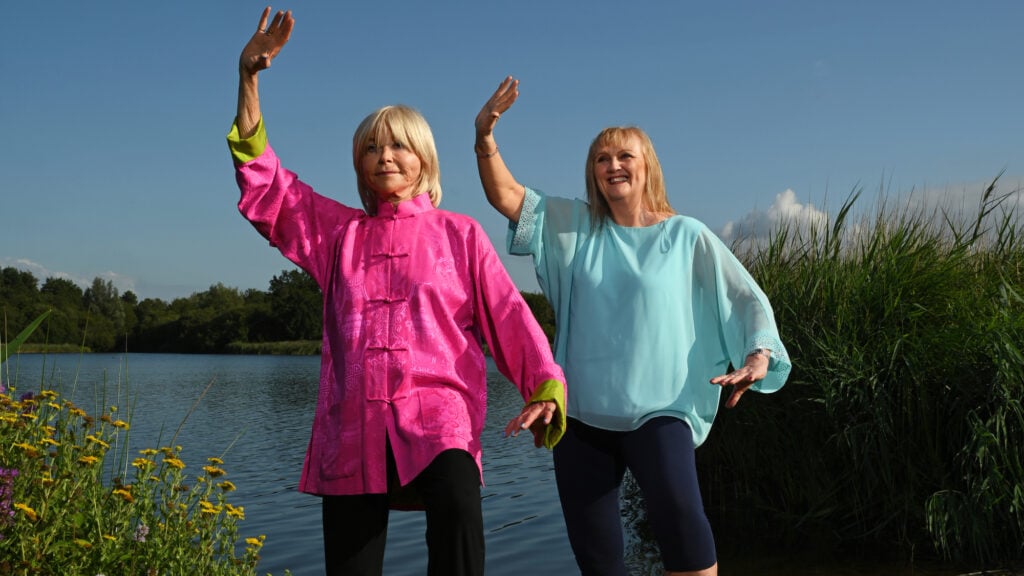Could tai chi improve your health?
Self-confessed couch potato Pam Francis, 70, discovered tai chi and hasn’t looked back since
In May 2021 I joined a gym. Not just any gym, but one offering fitness classes with inspiring names like Blaze and Ignite.
After months of lockdowns, during which time I’d turned being a couch potato into an art form, I had to get active again. But when I arrived for my induction with a gym instructor virtually young enough to be my grandson, I froze.
In May 2021 I joined a gym. Not just any gym, but one offering fitness classes with inspiring names like Blaze and Ignite.
After months of lockdowns, during which time I’d turned being a couch potato into an art form, I had to get active again. But when I arrived for my induction with a gym instructor virtually young enough to be my grandson, I froze.
 Credit: John Millar
Credit: John MillarGyms, it seems, have moved on since I first joined one 20 years ago. They now come complete with overwhelming equipment and machines. And when I checked out members displaying incredible endurance on static bicycles, or doing Body Pump (which would have mine begging for mercy), I was worried I’d come to the wrong place.
Until I happened to peer through the window of a corner studio and saw a group of members moving slowly and gracefully doing tai chi to calming music. At last I’d found an exercise at the right pace for an unfit 70-year-old!
Like everyone, I’ve seen the older generation of China performing this ancient martial art with poise and beauty in their parks. Its benefits, such as increasing lifespan, are considered so impressive that the government of Hong Kong promotes the practice by providing free classes.
Supreme ultimate fist
I was fairly sceptical at first, but not any more. Tai chi is growing in popularity in the UK, with classes springing up everywhere. Also known as tai chi chuan (meaning ‘supreme ultimate fist’ because it was first developed as a fighting art), it combines deep breathing and relaxation with flowing movements, creating harmony between body and mind.
It can help us to reduce stress, improve posture, balance and general mobility, and increase muscle strength in the legs. And there is some evidence that tai chi can improve mobility in the ankles, hips and knees in those with rheumatoid arthritis.
One man who has experienced the benefits first-hand is Dr Mark Langweiler, lecturer in chiropractic at London South Bank University.
His medical background spans 30 years, specialising in pain management and orthopedics, and he has practised tai chi for more than 35 years. He says, ‘Obviously when you are shifting your weight back and forth in movements, you are improving your balance. So seniors are less likely to fall.
But research showed there were also improvements psychologically because they had more confidence and felt better able to navigate the world.’
Boxing the tiger’s ears
There are five different styles of tai chi, called Yang, Chen, Wu, Sun and Hao, the names of the Chinese families that developed the different movements.
They all share similarities, and the movements are inspired by nature and animals, hence the amusing descriptive names such as ‘Waving Hands Like Clouds’, ‘Boxing the Tiger’s Ears’, and ‘Pulling Nine Cows Around by their Tails’.
And magical names: ‘White Crane Spreads Wings’ and ‘Parting the Wild Horse’s Mane’.
It’s not about each move, but more about a series of fluid motions known as ‘forms’. In the Wu style, practised by Dr Langweiler, there is a primary form of 108 named moves. But you can learn a 12-movement form for home practice.
Many tai chi classes will also feature breathing and energy work known as qigong (pronounced chi kung – ‘chi’ being your life force or aliveness.)
‘Lately, given the pandemic, they have been using it for a lot of post-Covid patients who are still suffering long-term effects, and it seems to have a positive result,’ says Dr Langweiler.
Some of the moves involve balancing on one leg, which may sound easy, but you try it! To start with I looked like a drunk stork, and was prone to toppling. But after a few lessons, my balance had considerably improved.
 Credit: John Millar
Credit: John MillarAstonishing transformations
My teacher is Sue Woodd (suewoodd.com), 71, a senior instructor with the Tai Chi Union of Great Britain, whose background is in Chinese medicine. And during 30 years of practice she has taught hundreds of teachers and students all over the world.
She runs classes and tai chi retreats, noting astonishing transformations in some of her students. ‘Tai chi is something you can start at any age,’ she says. ‘Some of my class require chairs when they exercise, and yet they are still able to benefit from the movements.
It’s a way of keeping older people mobile, active and social. And learning new skills keeps our brains active.
‘When you see people doing tai chi in China in the parks in the morning, they are moving their bodies, stimulating their minds, and coordinating their movements with their breathing.
‘And they do it, not just because they’ve got the odd five minutes to kill, but to balance their energy to go through the day. And then in the evening, they do it again to release the stress of the day.
‘Tai chi helps your emotional and mental wellbeing,’ she adds, ‘learning to stop the endless thoughts and being able to focus on moving your body. It’s like a moving meditation, so instead of sitting on a cushion and trying not to think, your mind is totally engrossed in the movements within the body, and that in itself is healing and balancing. While you are doing tai chi, you are giving your mind a holiday.’
For me, it has certainly done that, taking me out of my head which is always full of intrusive thoughts, and back into my body.
So I plan to carry on ‘boxing the tiger’s ears’, ‘waving my hands like clouds’ and ‘pulling nine cows around by their tails’, well…until the cows come home. In tai chi, I have found my little place of calm.
Two moves to get you started
Put your weight onto one leg and step out on the other. With your right hand, bring your fingertips to the tip of your thumb. (This is a powerful gesture because your meridians, or energy pathways, begin and end in your fingers.) Lower your other hand down on the inside of the extended leg. This movement co-ordinates the ankles, wrists, elbows, shoulders, hips and knees. It also builds strength in the leg that is taking the body weight.
Take the weight on your right leg and ‘empty’ the left leg. This helps with balance and strengthens the legs. The right hand is blocking something coming towards your face, and the left hand is used to press down. The hands are allowing your shoulder blades to fan down your back, releasing tension in your shoulders.
This article first appeared in the October 2021 issue of Saga Magazine
Written by Pam Francis
Published: Updated:

